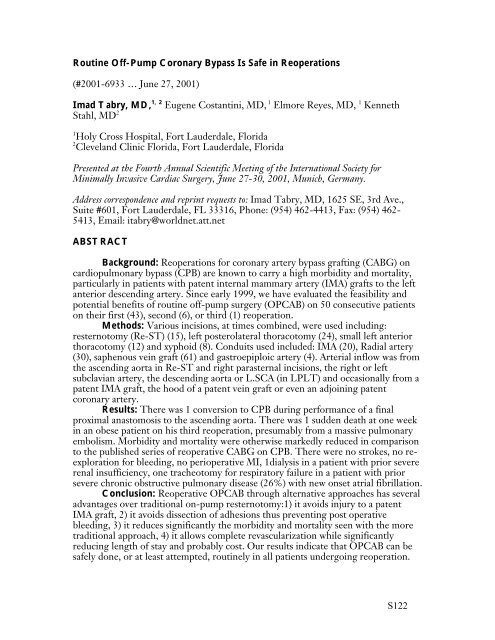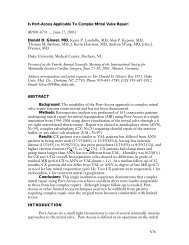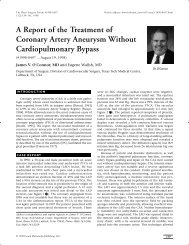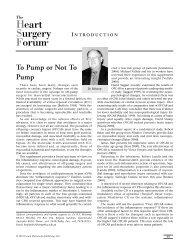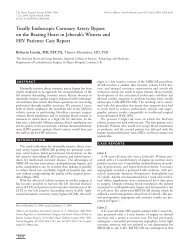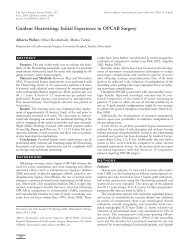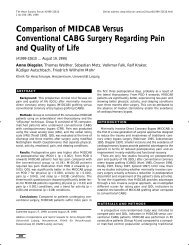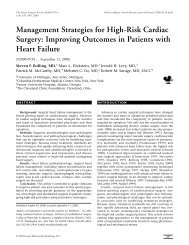(#2001-6933 … June 27, 2001) Imad Tabry, MD,1, 2 Eugene Costanti
(#2001-6933 … June 27, 2001) Imad Tabry, MD,1, 2 Eugene Costanti
(#2001-6933 … June 27, 2001) Imad Tabry, MD,1, 2 Eugene Costanti
Create successful ePaper yourself
Turn your PDF publications into a flip-book with our unique Google optimized e-Paper software.
Routine Off-Pump Coronary Bypass Is Safe in Reoperations<br />
(<strong>#<strong>2001</strong></strong>-<strong>6933</strong> … <strong>June</strong> <strong>27</strong>, <strong>2001</strong>)<br />
<strong>Imad</strong> <strong>Tabry</strong>, <strong>MD</strong>, 1, 2 <strong>Eugene</strong> <strong>Costanti</strong>ni, <strong>MD</strong>, 1 Elmore Reyes, <strong>MD</strong>, 1 Kenneth<br />
Stahl, <strong>MD</strong> 2<br />
1 Holy Cross Hospital, Fort Lauderdale, Florida<br />
2 Cleveland Clinic Florida, Fort Lauderdale, Florida<br />
Presented at the Fourth Annual Scientific Meeting of the International Society for<br />
Minimally Invasive Cardiac Surgery, <strong>June</strong> <strong>27</strong>-30, <strong>2001</strong>, Munich, Germany.<br />
Address correspondence and reprint requests to: <strong>Imad</strong> <strong>Tabry</strong>, <strong>MD</strong>, 1625 SE, 3rd Ave.,<br />
Suite #601, Fort Lauderdale, FL 33316, Phone: (954) 462-4413, Fax: (954) 462-<br />
5413, Email: itabry@worldnet.att.net<br />
ABSTRACT<br />
Background: Reoperations for coronary artery bypass grafting (CABG) on<br />
cardiopulmonary bypass (CPB) are known to carry a high morbidity and mortality,<br />
particularly in patients with patent internal mammary artery (IMA) grafts to the left<br />
anterior descending artery. Since early 1999, we have evaluated the feasibility and<br />
potential benefits of routine off-pump surgery (OPCAB) on 50 consecutive patients<br />
on their first (43), second (6), or third (1) reoperation.<br />
Methods: Various incisions, at times combined, were used including:<br />
resternotomy (Re-ST) (15), left posterolateral thoracotomy (24), small left anterior<br />
thoracotomy (12) and xyphoid (8). Conduits used included: IMA (20), Radial artery<br />
(30), saphenous vein graft (61) and gastroepiploic artery (4). Arterial inflow was from<br />
the ascending aorta in Re-ST and right parasternal incisions, the right or left<br />
subclavian artery, the descending aorta or L.SCA (in LPLT) and occasionally from a<br />
patent IMA graft, the hood of a patent vein graft or even an adjoining patent<br />
coronary artery.<br />
Results: There was 1 conversion to CPB during performance of a final<br />
proximal anastomosis to the ascending aorta. There was 1 sudden death at one week<br />
in an obese patient on his third reoperation, presumably from a massive pulmonary<br />
embolism. Morbidity and mortality were otherwise markedly reduced in comparison<br />
to the published series of reoperative CABG on CPB. There were no strokes, no reexploration<br />
for bleeding, no perioperative MI, 1dialysis in a patient with prior severe<br />
renal insufficiency, one tracheotomy for respiratory failure in a patient with prior<br />
severe chronic obstructive pulmonary disease (26%) with new onset atrial fibrillation.<br />
Conclusion: Reoperative OPCAB through alternative approaches has several<br />
advantages over traditional on-pump resternotomy:1) it avoids injury to a patent<br />
IMA graft, 2) it avoids dissection of adhesions thus preventing post operative<br />
bleeding, 3) it reduces significantly the morbidity and mortality seen with the more<br />
traditional approach, 4) it allows complete revascularization while significantly<br />
reducing length of stay and probably cost. Our results indicate that OPCAB can be<br />
safely done, or at least attempted, routinely in all patients undergoing reoperation.<br />
S122
INTRODUCTION<br />
Conventional redo CABG on CPB carries a significant morbidity and<br />
mortality ([Loop 1990, Lytle 1997, He 1999] particularly in the presence of a preexisting<br />
patent IMA to LAD graft which may be traumatized during re-entry<br />
[Gillinov 1999]. In our Institution, after a 2-year learning period, (for both the<br />
surgeon and the anesthesiologist) all first time CABG operations are done on the<br />
beating heart (IFT). It was a natural progression to extend our experience with<br />
OPCAB to redo CABG. Thus, .in January 1999 we felt comfortable enough to<br />
initiate a prospective evaluation of 50 consecutive such patients to: 1) assess the<br />
technical feasibility of complete off-pump revascularization using alternative<br />
approaches, and 2) evaluate the overall immediate results associated with this<br />
procedure compared to traditional on-pump surgery.<br />
MATERIALS AND METHODS<br />
Between January 1999 and May <strong>2001</strong>, 50 consecutive patients underwent offpump<br />
redo CABG. This represented 11% of our total series of OPCAB procedures<br />
(450) .Age ranged from 43 to 87 years (mean 76.5) .32were males (64%) and 18<br />
females (36%). 43 had undergone 1 previous CABG, 6 had undergone 2 and 1 had<br />
undergone 3 such procedures.28 (56%) had a patent IMA graft to the LAD, 1had a<br />
patent IMA to the ramus intermedius and 3 a patent IMA to the first diagonal branch<br />
of the LAD.36% of all previously created vein grafts were partially patent and 18<br />
patients had undergone at least one prior angioplasty or stenting of a vein graft or<br />
native vessel. Mean time from the prior CABG procedure was 10 years (range 2.5 to<br />
18 years). Risk factors were common, including Diabetes mellitus (21 patients-42%),<br />
hypertension (25-50%), COPD (12-24%), chronic renal insufficiency (11-22%),<br />
prior CVA (4-8%), and ejection fraction less than 35% (29-58%).<br />
Surgical Techniques<br />
All patients were heparinized to maintain ACT around 400.CTS retractor<br />
system (CardioThoracic Systems Inc, Cupertino, CAL), stabilizer set and lift set<br />
were used mostly, though occasionally the Medtronic Octopus apparatus (<br />
Medtronic Cardiac Surgical Products, Grand Rapids, MI) was utilized. Single-lung<br />
ventilation was the norm whenever the incision was not a Re-ST.4 approaches,<br />
isolated or in combination, were used depending on the targets needing<br />
revascularization and the arterial inflow:<br />
1.Re Sternotomy was accomplished in 15 patients (30%) using a Stryker<br />
oscillating saw (Stryker Instruments, Kalamazoo, MI). This was invariably a full<br />
sternotomy. Re-ST was reserved to patients in need of revascularization of the right<br />
coronary artery (RCA), LAD and circumflex (CX) branches and who did not have a<br />
patent IMA –LAD graft. After taking down 1 or 2 IMAs as necessary, adhesions were<br />
carefully dissected around the aorta and right atrium first and then progressively<br />
around the entire heart. Because of the need to revascularize the CX branches in 14<br />
of these 15 patients and the usual presence of extensive adhesions and fibrous<br />
scarring around a patent IMA to LAD graft preventing satisfactory exposure of these<br />
targets, this approach was not used in the presence of a patent IMA graft. All distal<br />
anastomoses were done using our standard OPCAB technique: simple<br />
immobilization of the target vessel using the stabilizer set without sling occlusion,<br />
S123
arteriotomy, insertion of temporary shunt (Flo-Thru, Bio-Vascular Inc) or stent<br />
(Flo-Rester, Bio-Vascular Inc), anastomosis using a CO 2 blower, removal of the<br />
shunt and completion of the suture line if necessary for hemostasis then knot tying.<br />
The LAD was first perfused with the IMA when feasible, but no effort was made to<br />
systematically perfuse other grafts immediately after the distal anastomosis was<br />
completed. No adjunctive aorto-coronary shunts were used for this purpose.<br />
Proximal anastomoses were done to the ascending aorta, or, when diseased, to the<br />
IMA itself or to the hood of an old patent vein graft. Old grafts were left intact and<br />
were never divided whether still patent or occluded.<br />
2.A Standard Left Posterolateral Thoracotomy, entering the chest in the fifth<br />
or sixth intercostals space, was performed after harvesting saphenous vein grafts,<br />
radial arteries and GEA in the supine position and using single lung ventilation (24<br />
cases-48%). This was our favorite exposure in the presence of a functioning IMA-<br />
LAD graft. The femoral vessels were not exposed. The inferior pulmonary ligament<br />
was divided and just enough adhesions between the lung and the pericardium were<br />
taken down in order to avoid postoperative air leaks. Longitudinal pericardiotomy<br />
behind the phrenic nerve generally provided excellent exposure of the entire CX<br />
system and frequently of the distal branches of the RCA (posterolateral and less often<br />
the PDA). Exposure of the diagonal branch of the LAD, the distal LAD and the IMA<br />
graft was achieved by incising the pericardium anterior to the phrenic nerve and up<br />
to the “point of entry”of the IMA graft or as high as feasible. Target vessel<br />
identification was greatly facilitated by following the course of old vein grafts.<br />
Stabilization of the target vessels was ensured by the use of the CTS retractor<br />
(CardioThoracic Systems, Inc.Cupertino, CA) instead of the usual thoracotomy<br />
retractor. Because careful planning of the course of the grafts from the Descending<br />
aorta (Des-Ao) to the target vessel/s is crucial to avoid kinking, we have not<br />
hesitated, when deemed necessary, to perform the proximal anastomosis first. The<br />
distal Des-Ao was used as the inflow for distal CX grafts, while the proximal Des-Ao<br />
(above the hilum) was a more appropriate site of inflow in the case of ramus or very<br />
proximal CX grafts. A metal marker ring was always placed around the proximal<br />
anastomosis for further reference should the need arise to assess graft patency by<br />
angiography. A 0.5% Marcaine was infiltrated in the adjoining intercostal spaces<br />
prior to closure, and more recently an indwelling intrapleural catheter connected to a<br />
morphine or marcaine pump has been left in place for 2-3 days postoperatively.<br />
3.MIDCAB technique (12 cases-24%) was performed in the following<br />
fashion: through a 4 “ incision in the 4 th intercostals space careful dissection of the<br />
skeletonized IMA was done with low current electrocauthery and fine clips from its<br />
origin to the 6 th intercostal space under direct vision and using the CTS Lift set<br />
(CardioThoracic Systems, Inc.Cupertino, CA) assisted with intracavitary lighting<br />
and single-lung ventilation. After switching to a CTS Stabilizer set (CardioThoracic<br />
Systems, Inc.Cupertino, CAL) the pericardium was incised to expose the LAD and<br />
Diagonal. Deep pericardial sutures or a small laparotomy sponge placed behind the<br />
apex of the heart allowed satisfactory exposure. When necessary to bypass both the<br />
LAD and a Diagonal branch, major consideration was given to the proximity of the 2<br />
vessel. If the vessels were separated by an acute angle, the IMA was anastomosed to<br />
both in a sequential fashion. If they were farther apart, it was necessary to “Y” the<br />
IMA or interpose a segment of radial artery. On 4 occasions, when a free graft was<br />
used (radial artery or saphenous vein), the MIDCAB incision was supplemented with<br />
a left subclavicular incision to provide arterial inflow from the axillary artery.<br />
S124
4.Xyphoid-Upper abdominal incision (8cases-16%) was always performed in<br />
combination with another approach ( MIDCAB in3, and LPLT in5) .After<br />
harvesting the GEA (4), the xyphoid was excised in its totality and up to one inch of<br />
lower sternum was removed with the Stryker saw as an inverted V in patients with a<br />
narrow lower sternal angle. This allowed excellent exposure of the RCA and its<br />
branches, thus avoiding the need to reopen the entire sternum. Three maneuvers<br />
were very helpful in exposing the deep seated vessels: 1) elevation of the lower sternal<br />
edge with a Rultract type retractor (Rultract, Inc., Cleveland, Ohio) while keeping<br />
anterior adhesions intact, 2) deep retraction sutures on the diaphragm exiting<br />
through the abdominal wall rather than through the incision itself, and 3) steep<br />
Trendelenburg position of the patient Extra long forceps and needle holders<br />
facilitated performance of the distal anastomoses.<br />
Heparin was partially reversed in all patients. Temporary pacing wires were<br />
seldom used .The chest cavity was drained using 2 Blake silicone drains (Gish<br />
Biomedical, Irvine, CA). Simultaneous procedures included:1 carotid endarterctomy<br />
in a patient with critical internal carotid stenosis and an occluded contralateral<br />
carotid, and 2 extended LAD endarterectomies on patients with patent IMA grafts<br />
but extensive disease distally precluding simple grafting. Graft flows were measured<br />
in the more recent 12 patients using the Butterfly Flowmeter (Medi-Stim AS, c/o<br />
Medtronic Inc., Minneapolis, MN). Routine administration of Aspirin, Plavix and<br />
subcutaneous Lovenox postoperatively was used to counteract the hypercoagulable<br />
state described in OPCAB surgery [Mariani1999]. Hybrid procedure (balloon<br />
angioplasty-stenting of a CX branch) was done in an elderly gentleman 24 hours<br />
after a MIDCAB (LIMA to LAD graft)<br />
.<br />
RESULTS<br />
There was 1 conversion to CPB, ironically during performance of the final<br />
proximal anastomosis of a vein graft to the ascending aorta in a patient undergoing<br />
Re-ST and three vessel grafting. Presumably there was partial occlusion of a vital<br />
patent old vein graft to the ramus resulting in intractable ventricular fibrillation.<br />
CPB was instituted for 15 minutes after which the patient resumed excellent<br />
hemodynamics and subsequently had an uneventful recovery.<br />
There was 1 sudden death on the 7th postoperative day in a 43 year old obese<br />
(<strong>27</strong>0lbs) patient with COPD on his 3rd reoperation for CABG. The left IMA had<br />
been harvested without difficulty through a MIDCAB incision, however we were<br />
unable to identify with certitude the LAD which was buried in fat. We resorted to a<br />
tertiary Re-ST which then allowed identification of the LAD. The anastomosis<br />
between LIMA and LAD was then carried out as planned through the MIDCAB<br />
incision to avoid further dissection of adhesions and injury to the heart. Excellent<br />
flows were measured. His recovery was relatively uneventful, though extubation was<br />
delayed for 24 hours. He succumbed suddenly on day 7 after a respiratory arrest<br />
sustained while in the step-down unit, presumably as a result of a massive pulmonary<br />
embolism. Autopsy was not obtained.<br />
There were no instances of perioperative MI either by EKG, cardiac enzymes<br />
or troponin levels. There were no documented strokes.42 patients (85%) were<br />
extubated within 8 hours of completion of surgery. Total postoperative length of stay<br />
averaged 4.5 days (3-9 days) .Prolonged ventilation leading to tracheotomy was<br />
necessary in a patient with severe COPD. This same patient, with preoperative<br />
S125
creatinine of 3.2 required permanent hemodialysis. There were three readmissions<br />
for shortness of breath and pleural effusions resolving after thoracentesis. One<br />
patient had a documented episode of pulmonary embolism. New onset atrial<br />
fibrillation occurred in 13 patients (26%), while 3 had chronic atrial.fibrillation.<br />
There were no instances of reexploration for bleeding and transfusions were limited<br />
to elderly patients with Hemoglobin less than 8or Hematocrit less than 24%.There<br />
were no wound infections. On follow-up, only 1 symptomatic patient so far has<br />
required restudy; his sequential radial artery graft to 2 branches of the CX artery<br />
originating from the Desc-AO was widely patent.<br />
In this series, Re-ST allowed total revascularization (1-6grafts) using any<br />
conduit. Successful grafting of CX artery branches was achieved in 14 of 15 patients<br />
in this group. However severe pulmonary hypertension and/or cardiomegaly,<br />
pronounced chest wall deformities, previous radiation therapy or mediastinitis<br />
precluded use of this approach.<br />
LPLT allowed exposure of the CX artery branches primarily. It also was used<br />
for simultaneous grafting of the distal LAD (beyond a patent or diseased IMA),<br />
diagonal branches, ramus arteriosus, and frequently distal branches of the RCA. On<br />
three occasions a vein graft was first anastomosed to the posterior descending branch<br />
(PDA) of the RCA through a xyphoid approach, then tunneled to the left chest and<br />
anastomosed to the Desc-AO after re-positioning and draping the patient for a<br />
LPLT.<br />
MIDCAB was used exclusively for revascularization of the LAD and diagonal<br />
branches. It was combined with a subclavicular incision [Coulson1997] to provide<br />
arterial inflow in cases where a free graft was necessary (3) .An H-Graft [Cohn 1998]<br />
was used in 2 elderly patients.<br />
XY was performed primarily for exposure of the RCA and its branches and<br />
harvesting of a GEA. It was never isolated as, with the exception of the in situ GEA<br />
(4), it does not by itself provide a source of arterial inflow. This was provided instead<br />
by the Desc-AO (3) and the R. SCA (with the vein graft routed intrapleurally) (1).<br />
Immobilization of the target vessel was less satisfactory with this approach<br />
irrespective of the type of device used because of the absence of a bony support<br />
However it was greatly facilitated by keeping division of adhesions to a minimum<br />
and lifting the lower sternum with a Rultract type of retractor (Rultract Inc,<br />
Cleveland, OH).<br />
DISCUSSION<br />
CPB has been known to have deleterious effects on patients undergoing<br />
CABG surgery, particularly in the presence of significant comorbid conditions. For<br />
this reason OPCAB was popularized by Buffolo[Buffolo1996] and Benetti<br />
[Benetti1991]and shown, though not conclusively yet, to reduce morbidity, mortality<br />
and cost of this procedure. At our Institution and after a two-year learning period,<br />
we have been able to adopt OPCAB exclusively for isolated primary coronary<br />
revascularization with a negligible conversion rate and mortality less than 1% in all<br />
comers (IFT). More recently, it became evident that if the same technique could be<br />
applied to the more complex reoperations for CABG, their significant associated<br />
morbidity and mortality could also be markedly reduced. Like our vascular surgery<br />
colleagues who avoid areas of scarring –or infection- by approaching their target<br />
vessels “extra-anatomically”, we utilized alternative strategically placed incisions<br />
S126
aimed at: 1) avoiding sternal re-entry problems (IMA injury, myocardial tears, lysis of<br />
dense adhesions, sternal wound infection), 2) obtaining adequate exposure of all<br />
target vessels and3) ensuring a good source of arterial inflow. Our limited experience<br />
with 50 consecutive cases centered on the following guidelines:<br />
1) Patients with a patent IMA-LAD graft are the ones to benefit the most<br />
from alternative “extra-anatomic” incisions (LPLT, MIDCAB or XY or a<br />
combination) particularly when a CX artery branch needs revascularization. Re-ST<br />
in such patients does not usually provide adequate exposure of the lateral wall of the<br />
heart, as retraction is severely limited by the fixed and shortened IMA pedicle (The<br />
same limitation theoretically exists in reoperation with a patent GEA to any target<br />
vessel). Endarterectomy of the distal LAD in patients with progression of disease<br />
beyond a patent IMA or vein graft can be safely done through a LPLT or a Re-ST<br />
respectively without any adjunct other than the use of a Florester (Flo-Rester, Bio-<br />
Vascular, Inc).<br />
2) In the absence of a patent IMA-LAD graft and in patients requiring<br />
multiple vessels revascularization involving RCA, LAD and CX branches, Re-ST<br />
provides excellent exposure in addition to allowing harvesting of one or two IMAs.<br />
Traditional precautions need to be exercised, particularly avoiding manipulation of<br />
old but patent vein grafts and finding the correct plane of dissection to avoid<br />
myocardial injury. Complete dissection of the heart all around, wide incision of the<br />
right pleura, placement of deep pericardial retraction sutures and Trendelenburg<br />
position, all facilitate performance of an operation that should be similar in simplicity<br />
to a primary OPCAB.<br />
3) When a single or a double bypass needs to be done, there are multiple<br />
potential strategies that do not necessitate Re-ST. In the case of the RCA, it is<br />
generally accepted that, because of progression of disease in the main artery, its<br />
branches (the PDA and the Postero-lateral) are better suited for bypass. These<br />
branches can be easily exposed through a XY- upper abdominal approach. Through<br />
this incision, the GEA can be harvested and used in-situ. If instead a free graft is<br />
used, arterial inflow can be provided by the R.SCA (subclavicular incision) or the<br />
ascending aorta (right parasternal incision) .The graft can also be tunneled to the left<br />
chest and connected to the Desc-AO through a separate LPLT incision in patients<br />
who need simultaneous X revascularization. In the case of the CX artery branches<br />
their exposure is simplified by a traditional LPLT approach, particularly in the<br />
presence of a patent IMA graft. Inflow is readily provided by the Desc-AO, below or<br />
above the hilum depending on the best course of the graft and the presence of<br />
calcification in the aorta. The left subclavian artery, proximal to the origin of the<br />
IMA, can be used in case of calcification of the Des-AO.A short period of temporary<br />
clamping of the SCA and EKG observation is advisable in that case.<br />
4) The MIDCAB incision provides excellent exposure of the LAD and its<br />
diagonal branches, even in the presence of a patent IMA-LAD graft. It allows easy<br />
harvesting of the IMA, and in cases where a free graft is used it can be combined<br />
with a small subclavicular incision to access the L.SCA .<br />
5) Frequently the combination of a MIDCAB or a LPLT incision with a XY<br />
and/or a subclavicular incision will allow total “extra-anatomic” revascularization of<br />
all targeted vessels. In these cases sources of arterial inflow are readily available and<br />
include: the right and left SCA through appropriate small subclavicular incisions, the<br />
ascending aorta through a small right parasternal incision, and the Des-Ao or L.SCA<br />
in LPLT. The hood of an old vein graft, a patent IMA graft and an adjoining patent<br />
S1<strong>27</strong>
coronary artery branch can also be used as a source of arterial inflow.<br />
Last but not least, good anesthesia has proved to be crucial for the success of<br />
OPCAB surgery. It is even more crucial in redo OPCAB surgery, a generally more<br />
challenging operation which can turn into a frustrating experience if hemodynamic<br />
instability is not anticipated and treated appropriately. Continuous communication<br />
between anesthesiologist and surgeon allows smooth progression of the procedure<br />
without unnecessary delays and conversion to CPB. Volume management,<br />
particularly reinfusing shed blood, saved with the cell saver, in elderly patients is<br />
paramount. Appropriate pharmacological intervention to stabilize blood pressure,<br />
particularly during performance of the distal CX grafts, is accomplished with the use<br />
of norepinephrine and neosynephrin and/or nitroglycerine. When atrial fibrillation<br />
occurs during cardiac manipulation, cardioversion is done and the procedure<br />
resumed. Calcium channel blockers are routinely administered throughout the<br />
procedure when radial artery grafts are used.<br />
By following these guidelines we were able to eliminate almost completely the<br />
morbidity and mortality associated with CPB. Length of hospitalization and cost<br />
were also markedly reduced. Thus we are of the opinion that, with proper planning<br />
and execution, re-operative OPCAB should be no more difficult to achieve<br />
technically than primary OPCAB, and should be at least attempted routinely by<br />
surgeons who have mastered beating heart surgery techniques. Most importantly it<br />
should achieve complete revascularization rather than be limited to the<br />
“culprit”vessel.<br />
CONCLUSION<br />
Redo CABG operations can be safely performed on a routine basis using<br />
traditional OPCAB techniques, provided “extra-anatomic” incisions are carefully<br />
planned to allow optimal arterial inflow and target vessel exposure and ensure<br />
complete revascularization .The early results in our small series of re-operative<br />
OPCAB are extremely encouraging and we have no reason to believe that the long<br />
term results will be less good than in primary OPCAB procedures.<br />
REFERENCES<br />
1.Benetti FJ, Naselli G, Wood M, Geffner L.Direst myocardial revascularization<br />
without extracorporeal circulation.Experience in 700 patients.Chest 100 (2) :312-9,<br />
1991<br />
2.Buffolo E, Silva de Andrade JC, Rodrigues Branco JN et al. Coronary artery bypass<br />
surgery without cardiopulmonary bypass.Ann Thorac Surg 61:63-6, 1996<br />
3.Cohn WE, Suen HC, Weintraub RM, Johnson RG. The “H” graft:alternative<br />
apptoach for performing minimally invasive direct coronary artery bypass.J Thorac<br />
Cardiovasc Surg 115:148-51, 1998<br />
4.Coulson AS, Bakhshay SA.Subclavian artery origin for a coronary bypass<br />
graft.Contemp Surg 50:65-6, 1997<br />
5.Gillinov AM, Casselman FP, Lytle BW et al.Injury to a patent left internal thoracic<br />
artery graft at coronary reoperation.Ann Thorac Surg 67 (2) :382-6, 1999<br />
6.He GW, Acuff TE, Ryan WH, He YH, Mack MJ.Determinants of operative<br />
mortality in reoperative coronary artery bypass grafting.J Thorac Cardiovasc Surg<br />
68:2215-9, 1999<br />
S128
7.Loop FD, Lytle BW, Cosgrove DM et al.Reoperation for coronary<br />
atherosclerosis:changing practice in 2509 consecutive patients.Ann Surg 212:378-86,<br />
1990<br />
8.Lytle BW, Navia JL, Taylor PC, et al.Third coronary artery bypass<br />
operations:risks and costs.Ann Thorac Surg 64 (5) :1287-95, 1997<br />
9.Mariani MA, Gu YI, Boonstra PW et al.Procoagulant activity after off pump<br />
coronary operation:Is the current anticoagulation adequare?Ann Thorac Surg<br />
67:370-75, 1995<br />
S129


